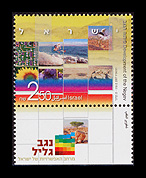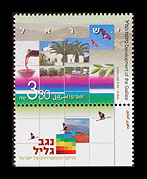|
|
From the early days of the Zionist movement, through the birth of the State of Israel and to the present day, settlement of Eretz Yisrael, in general, and the Negev and the Galilee, in particular, was a key objective. Agricultural activity was at the core of the first settlement initiatives, but today, this has been enriched by industrial development, in the form of hi-tech plants and enterprises, and tourism promotion.
The State of Israel has recognized the important role of the development of these two major regions – the Negev and the Galilee – in Israel's security, and the extent to which it can upgrade the quality of life and well-being of the population that calls the Negev and the Galilee home.
The importance of developing and strengthening the Negev and the Galilee has been at the center of attention in recent years, culminating in the establishment
of a special ministry headed by Vice Prime Minister Shimon Peres, whose specific task is to focus on the development of these regions. The strategic decision to promote Negev and Galilee development has been further consolidated by the decision to devote Israel's 58th year of independence to the development of the Negev and the Galilee, and the approval of, and provision of budgets for, short-and long-term projects for the development of the two regions.
The State of Israel's vision for these regions, which together cover over 70% of the country's territory, is to: generate a larger and wider range of employment opportunities; empower individuals to realize their personal ambitions, and create a quality of life that is superior to any in the center of the country; pave new roads, literally, for those who decide to build a new life in the Negev and the Galilee; and exploit to best advantage the distinctive traits of these regions – the scenic views, human and natural capital, and cultural diversity – with a manifest effort to safeguard the special beauty and landmarks for which these regions are renowned.
The Negev, over half of Israel's territory in size, spreads from Beer-Sheba in the north of the region to Eilat in the south. The desert terrain of the Negev is mostly unpopulated, yet scores of settlements are spread within its borders: cities, villages, kibbutzim, cooperative settlements and scattered isolated settlements. Beer- Sheba, the fifth largest city of Israel and the capital of the Negev, is situated in the center of Israel, and at the region's southernmost tip lies the pearl of the tourist industry, Eilat. The wild and pristine beauty of the Negev constitutes a unique tourist attraction, the agricultural opportunities it offers are tremendous and the its wide open spaces are beyond compare.
The Galilee, which represents 30% of Israel's territory, spreads north from the Yokne'am-Jezreel Valley line and includes Western Galilee, Upper and Lower Galilee, the Golan Heights and the Sea of Galilee (Kinneret) belt. The Galilee, like the Negev is distinguished by a diversity of settlements, ranging from large towns such as Tiberias, Nahariya, and Safed, alongside kibbutzim, cooperative settlements and scattered observation posts. The major portion of Israel's water sources, principally the Jordan River and the Sea of Galilee, are situated in the Galilee, and together with its range of mountains and extensive verdant forests, the region is celebrated for its breathtaking beauty. The multi-ethnic character of the Galilee's population – Jews, Moslem and Christian Arabs, Druze and Circassian communities – has created an outstanding cultural mosaic. The large number of tourist attractions to which tourists from Israel and abroad flock serve as the main sources of employment in the region. Galilee residents also make their living in fields such as the hi-tech industry, agriculture and education.
The Vice Prime Minister's Office, responsible for the Negev's and Galilee's development, believes that the personal well-being of the inhabitants – jobs, quality of life, education and community building activities –will promote widespread regional prosperity and help realize the tremendous potential of these regions, both on the personal and national level.
The combination of agriculture and industry, urban and rural life, Jews and Arabs, mountain and desert populations, forms the special fabric of the Negev and the Galilee. This is where the pioneers of the years 2000 reside. Initiatives to strengthen the existing population and designed to attract new residents, the development of infrastructures and job opportunities, and the promotion of educational and cultural systems, will serve as the gateway to prosperity and success for the Negev and the Galilee.
Vice Prime Minister Office


